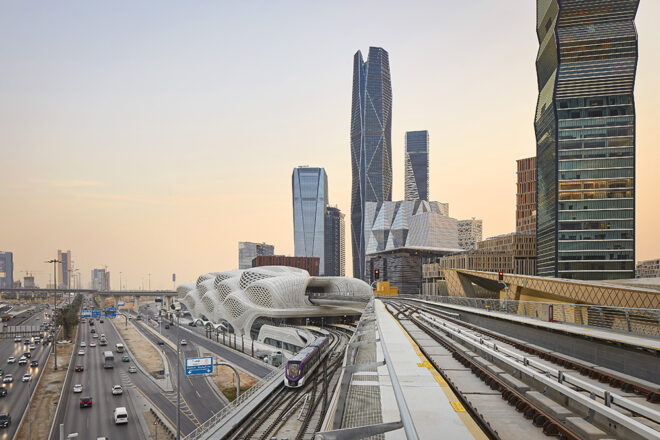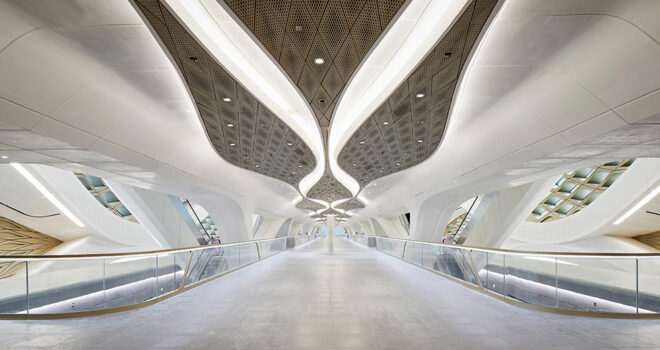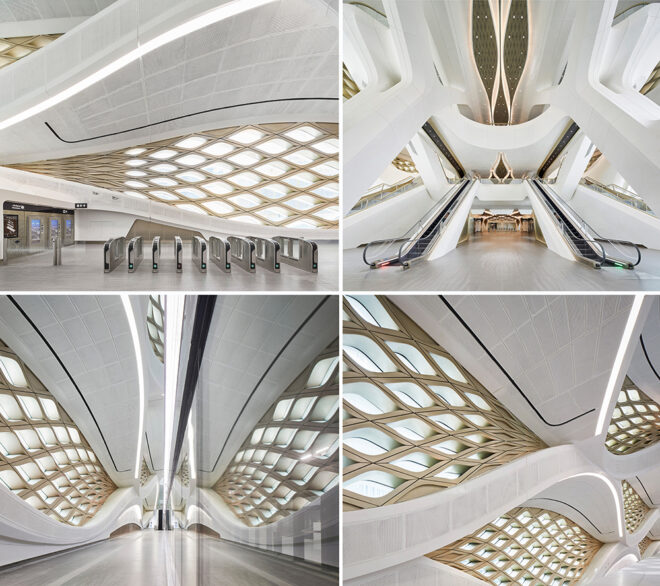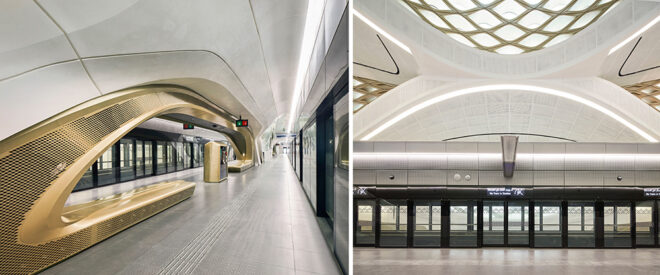A new beating heart for Riyadh: The KAFD Metro Station
in ARCHITETTURA | architecture

© Hufton+Crow I KAFD Metro Station.
Today, a new chapter is being written in the history of Riyadh. With vibrant energy and palpable anticipation, the Saudi capital inaugurated three new metro lines: lines 1, 4 and 6 (Blue, Yellow and Purple respectively). A complex and colossal engineering work, the result of years of planning and construction, which extends for 176 kilometers, making it the longest driverless transport network in the world. With a capacity of over 3.6 million passengers per day, this new urban artery promises to revolutionize the city’s mobility, alleviating chaotic traffic and drastically reducing travel times. But the Riyadh metro is not just a means of transport, it is a symbol of modernity and progress. Its stations – 85 – were designed with an eye to aesthetics and functionality. Some of which are true transport “cathedrals” such as the King Abdullah Financial District (KAFD) station, designed by the famous British studio Zaha Hadid Architects.

© Hufton+Crow I KAFD Metro Station.
A fluid and futuristic architecture, which almost seems to dance in space, welcomes passengers in a bright and welcoming environment. This mobility center, with its six tracks distributed over four levels, is a real strategic point of reference for the city, connecting the metropolis to King Khalid International Airport and providing access to the skybridge for the local KAFD monorail. Here, trains, buses and cars converge in a continuous flow, creating an unprecedented multimodal interchange hub. And for those who want to take a break from the frenzy of the city, the new internal and external public spaces offer an ideal environment to relax and socialise.

© Hufton+Crow I KAFD Metro Station.
The station, the beating heart of the city, turns out to be a living organism, where the flows of people create a dynamic rhythm, similar to sound waves that propagate in space, which is captured and amplified by the architecture. The walls, covered with high-performance concrete panels, vibrate with this energy, transforming into a sort of sinusoidal diaphragm that transmits the pulsation of internal life to the outside. The plastic shell of the building, shaped as if by the gusts of the wind that shape the dunes, is perforated by geometric holes. This is not just an aesthetic element to lighten the volume of the complex, but an intelligent response to the local climate. Like ancient vernacular buildings, the station is protected from the sun. The natural light filtered inside creates plays of shadows and reflections that continuously change throughout the day and contribute to creating both a welcoming environment and a dynamic and engaging atmosphere.

© Hufton+Crow I KAFD Metro Station.
The interior of the station is a unique sensory experience. The choice of precious materials and artisanal finishes gives the environment a timeless elegance. This station is not just a place of transit, but a Theater of Modernity that celebrates the beauty of nature and human ingenuity. A jewel of contemporary architecture that fits harmoniously into the urban landscape, becoming a point of reference for the city and a symbol of progress and innovation. The project was continuously optimized by ZHA throughout its development to increase structural efficiency and environmental performance, while simplifying the construction process without compromising spatial quality; perfectly integrating the self-supporting structure of the external envelope with the internal structure of the station which supports the railway platforms and viaducts.

© Hufton+Crow I KAFD Metro Station.
Traveling within this station is a unique experience, characterized by comfort and sustainability. Thanks to careful design and cutting-edge technologies, the station offers a fresh and pleasant environment at all times of the day. The air conditioning system, powered by renewable sources, automatically adapts to the number of passengers, always guaranteeing an ideal temperature. Sliding doors, in addition to improving energy efficiency, help create a quieter and more comfortable environment. The LEED (Leadership in Energy and Environmental Design) Gold certification by the United States Green Building Council confirms that the KAFD Metro Station is an example of excellence in the field of sustainable architecture and urban mobility.

© Hufton+Crow I KAFD Metro Station.
Thanks to this new network, the most remote neighborhoods of the city will finally be within reach, and citizens will be able to discover new corners of their capital. The inauguration of the Riyadh metro marks a turning point for Saudi Arabia, which looks to the future with ambition and determination. A work that will not only improve the quality of life of its citizens, but will also contribute to strengthening its role as an international economic and cultural hub.
